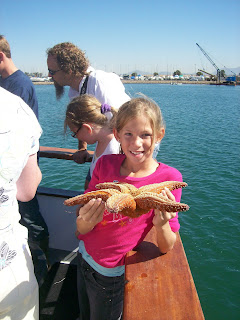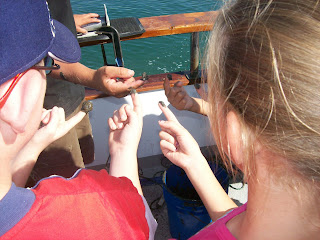Thursday, October 30, 2008
Legoland
My brother's favorite part was seeing all the buildings made out of Legos. They had Washington D.C., New York, Las Vegas, and many many more. They were like little towns, but all made of Legos.
I don't have any pictures because my mom forgot the camera and we bought a camera to use. But we didn't put the pictures on the computer.
Sea World

We got to go to Sea World again! We saw Shamu, the famous whale. We learned that he can swim 30 mph. The trainers talk to whales in sign language. We loved the show where the trainers rode on the whale. We also saw dolphins and how high they could jump. One d
 olphin jumped 60 feet into the air. We viewed beluga whales, a polar bear, walruses, and even manatees. We went in a shark tunnel and had sharks swimming over us. It was scary. Our favorite was the sea lion show. They would copy whatever the trainer did. We also saw penguins. They were small but could swim really, really fast!
olphin jumped 60 feet into the air. We viewed beluga whales, a polar bear, walruses, and even manatees. We went in a shark tunnel and had sharks swimming over us. It was scary. Our favorite was the sea lion show. They would copy whatever the trainer did. We also saw penguins. They were small but could swim really, really fast!
Channel Islands Marine Floating Lab


We went out on boat called a floating lab. We saw many pelicans on the rocks. There were dolphins and sea lions swimming alongside our boat. After sailing awhile we put out a large net and pulled it in to find all kinds of sea creatures. Our instructor, Tim, identified a lobster, a sea star, a crab, a sea urchin, and some fish. We got to touch and hold them too! He showed us how a sea star has many suction cups that attach to things, like even hair! The claws of a crab can be really strong too so we had to be careful holding the crab.
 Then we went down in the cabin below to see a huge microscope that
Then we went down in the cabin below to see a huge microscope that magnified a drop of ocean water. We could see and identify all kinds of little sea creatures alive in the water. It was amazing at all those tiny things that live in the water. Then he reminded us that sometimes we get a mouthful of ocean water when at the beach and swallow all these little critters--yuck!
magnified a drop of ocean water. We could see and identify all kinds of little sea creatures alive in the water. It was amazing at all those tiny things that live in the water. Then he reminded us that sometimes we get a mouthful of ocean water when at the beach and swallow all these little critters--yuck!Another instructor showed us how to measure the depth of water, the temperature of the water, the color of the water, and the wind speed and direction on a boat. The last station we went to was the "mud" station where we got to put a mud scooper into
 the ocean and bring up some mud. We searched through the mud looking for any shells or living creatures. Finally we got to TASTE the mud. It tasted like salty play dough combined with dirt!
the ocean and bring up some mud. We searched through the mud looking for any shells or living creatures. Finally we got to TASTE the mud. It tasted like salty play dough combined with dirt!  That crusty taste stayed in our mouth until lunch time.
That crusty taste stayed in our mouth until lunch time.It was a fun day out on the ocean. We even saw a dredging machine that got things out from the bottom of the ocean. We loved learning about and touching all the different creatures that live in our oceans.
Thursday, October 16, 2008
WindWolves Preserve

Went went to WindWolves Preserve south of Bakersfield. We learned how to survive in the wilderness if we ever got lost. We learned some of the foods we could eat if we were hungry like wild celery and stink melon. We tasted them both. The melon was pretty bad, but the wild celery that grew by the creek tasted the same as our
 celery. We learned to stay away from stinging nettles and poison oak. We saw what they both looked like. The Indians used the vine of the stinging nettles to make things with and even cooked the leaves and ate them. We also saw a humming bird nest and an animal skull.
celery. We learned to stay away from stinging nettles and poison oak. We saw what they both looked like. The Indians used the vine of the stinging nettles to make things with and even cooked the leaves and ate them. We also saw a humming bird nest and an animal skull.Our guide taught us how to trap an animal by using rocks and two
 sticks to set a trap to get the rock to fall on and kill a small animal.
sticks to set a trap to get the rock to fall on and kill a small animal.We learned to identify animal tracks of animals that live out in the valley wilderness.
 We made tracks of bobcats, deer, tule elk, bear, and mountain lion. We saw actual tracks of a tule elk and a bobcat and also saw deer by the road.
We made tracks of bobcats, deer, tule elk, bear, and mountain lion. We saw actual tracks of a tule elk and a bobcat and also saw deer by the road.Building a fire was really hard. Our docent showed us how we could use two sticks and rub them together or twirl one stick into another until we got sparks. We tried and tried but only felt the wood getting warm, no sparks.
 We learned to how to build a shelter if we ever got lost and needed shelter. Always have the door toward the east because the sun rises in the east and it will warm up the shelter. We used sticks
We learned to how to build a shelter if we ever got lost and needed shelter. Always have the door toward the east because the sun rises in the east and it will warm up the shelter. We used sticks  and brush to make our shelter. We also learned that you can live for six days without water and six weeks without food. I don’t think I’d live that long without food. It was all very interesting. I hope I am never lost in the wilderness.
and brush to make our shelter. We also learned that you can live for six days without water and six weeks without food. I don’t think I’d live that long without food. It was all very interesting. I hope I am never lost in the wilderness.
Tuesday, September 30, 2008
Native American Life
 Learning about the Yokuts Indians
Learning about the Yokuts IndiansWe went to the Kern County Museum and learned about the California Indians. It was the Indian girls who collected acorns for food. They had to dry them for a long time. Then they ground the acorns into powder
 with a pestle and a rock with a hole in it. We got to grind acorns into flour. Then we saw many of the baskets that were made by the Yokut Indians. Yokut Indians lived around Bakersfield. We also saw a real Indian bow and arrow they used for hunting deer and
with a pestle and a rock with a hole in it. We got to grind acorns into flour. Then we saw many of the baskets that were made by the Yokut Indians. Yokut Indians lived around Bakersfield. We also saw a real Indian bow and arrow they used for hunting deer and  rabbit. The end would come off so they would only lose the point of the arrow. We also saw a baby cradle made for a boy and another made for a girl.
rabbit. The end would come off so they would only lose the point of the arrow. We also saw a baby cradle made for a boy and another made for a girl.
Apple Picking

The Bakersfield Californian
Sarah and I went on a field trip this morning to the Bakersfield Californian.  We learned the process of making newspapers and so much more! First we went into a room with all the ads in it. Some stores make their own ads and others just tell them what they want and the Bakersfield Californian makes it for them. If we remember right, they have to make 80,000 ads! Wow! Instead of counting to find out if there are 80,000 ads they weigh them on a huge scale! Also, the ads must be in 3 weeks before the Sunday newspaper comes out.
We learned the process of making newspapers and so much more! First we went into a room with all the ads in it. Some stores make their own ads and others just tell them what they want and the Bakersfield Californian makes it for them. If we remember right, they have to make 80,000 ads! Wow! Instead of counting to find out if there are 80,000 ads they weigh them on a huge scale! Also, the ads must be in 3 weeks before the Sunday newspaper comes out.
 Next we went into a paper storage room. There he told us that they use 20-25 rolls of paper a day. Now if you’ve ever seen those rolls, they’re huge! Each of those large rolls cost $750. Paying for the paper is their main cost besides employees. He took us to a couple of other rooms but one of our favorites was the pressing room! Our tour guide explained how they can print black and white on both sides but color on only one side at a time. The machines that they use were massive!
Next we went into a paper storage room. There he told us that they use 20-25 rolls of paper a day. Now if you’ve ever seen those rolls, they’re huge! Each of those large rolls cost $750. Paying for the paper is their main cost besides employees. He took us to a couple of other rooms but one of our favorites was the pressing room! Our tour guide explained how they can print black and white on both sides but color on only one side at a time. The machines that they use were massive!
 After they printed and folded the papers they were transferred into another room by a cool conveyer belt thing. There, they sorted out the bad ones right when they entered the room, and then continued on the awesome conveyor belt. When they left the conveyor belt ads were stuck in them and then they were packaged into crates that were going to be delivered out to people and dispensers. One other interesting thing was they made all the news papers at night from about
After they printed and folded the papers they were transferred into another room by a cool conveyer belt thing. There, they sorted out the bad ones right when they entered the room, and then continued on the awesome conveyor belt. When they left the conveyor belt ads were stuck in them and then they were packaged into crates that were going to be delivered out to people and dispensers. One other interesting thing was they made all the news papers at night from about 